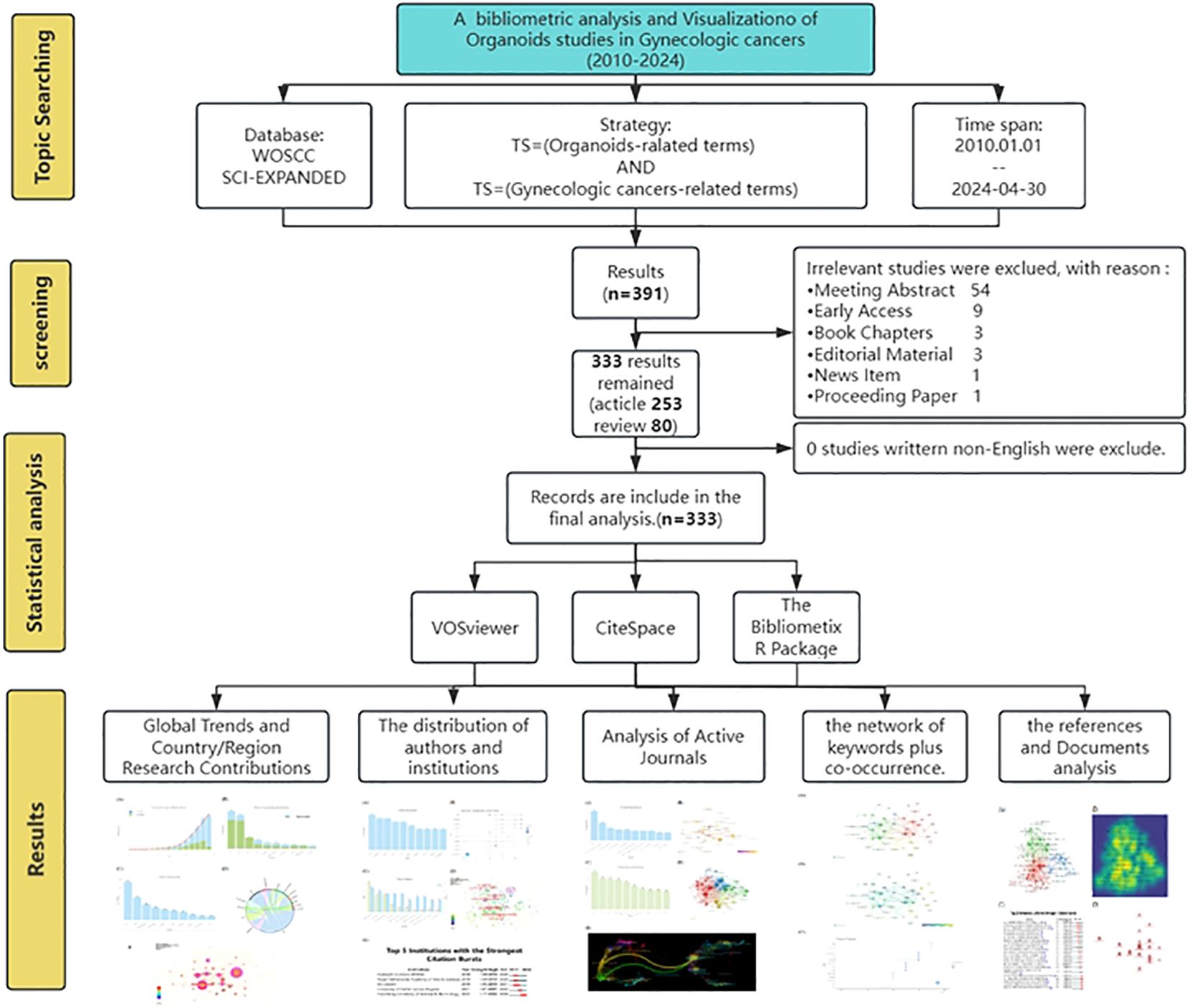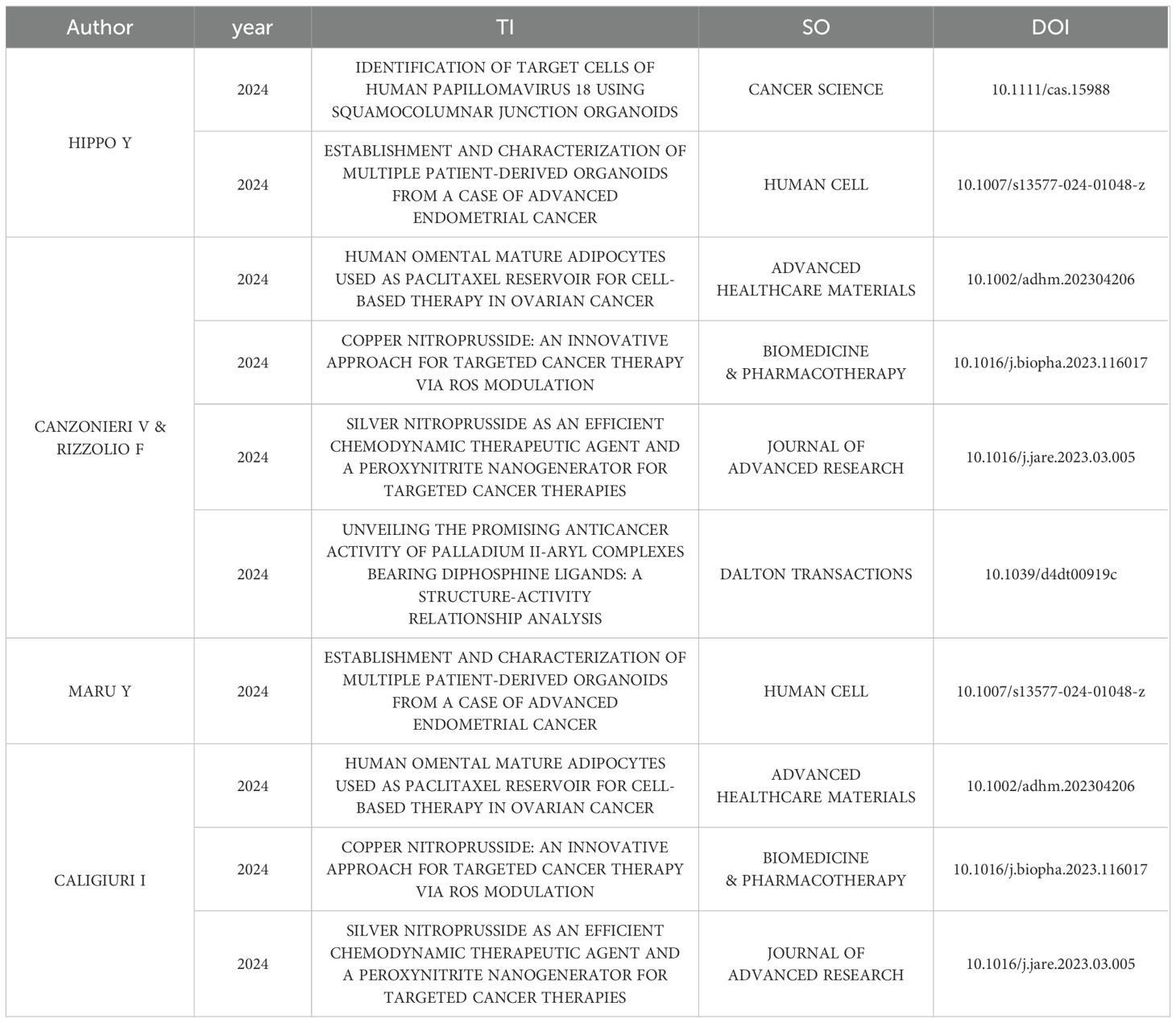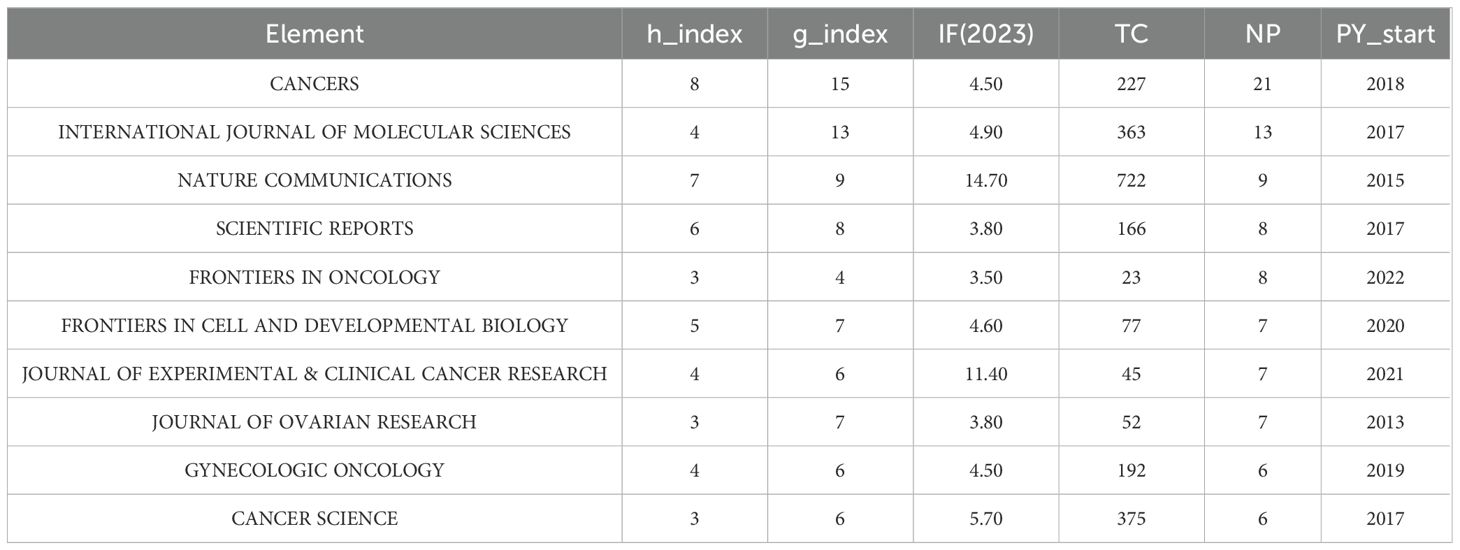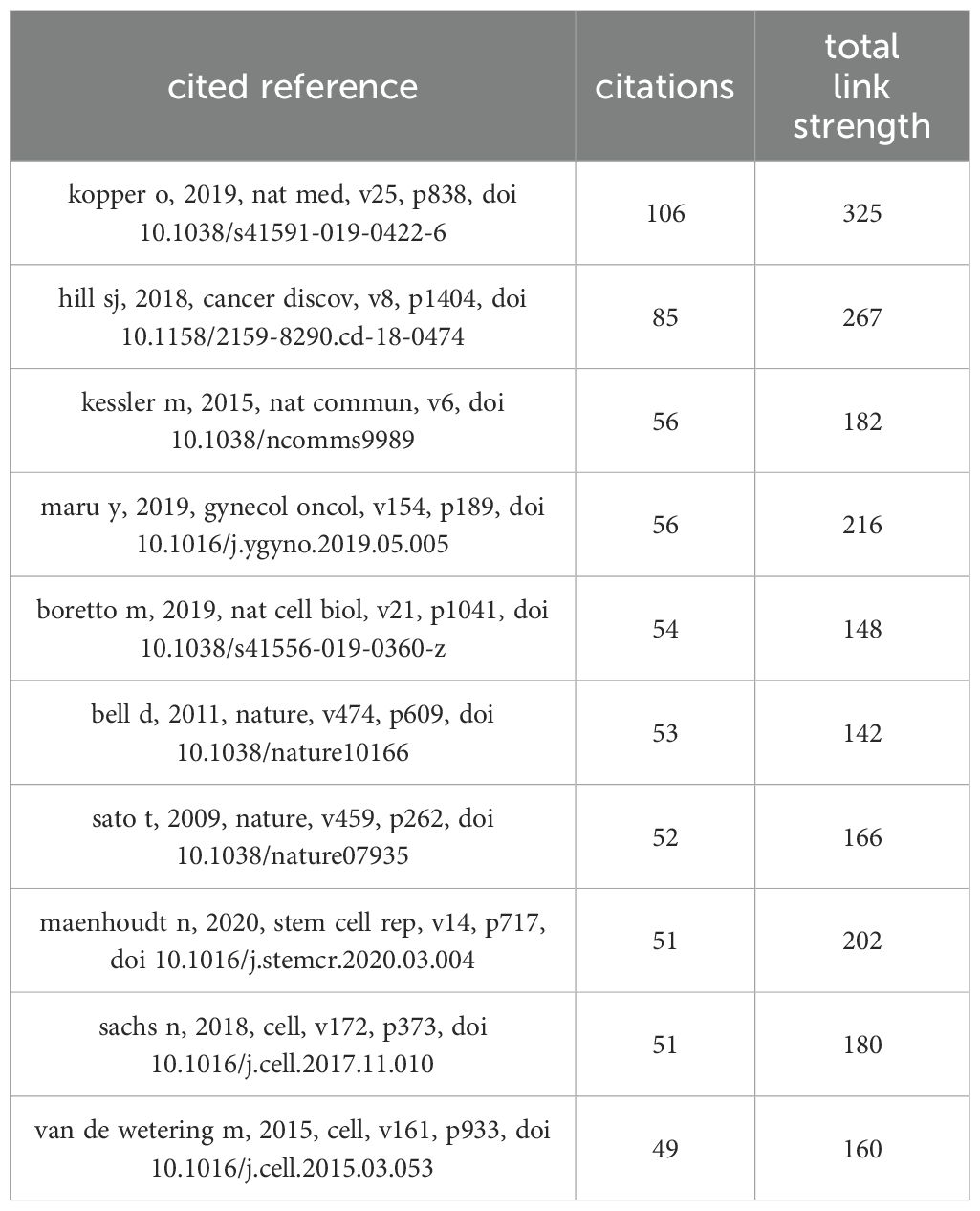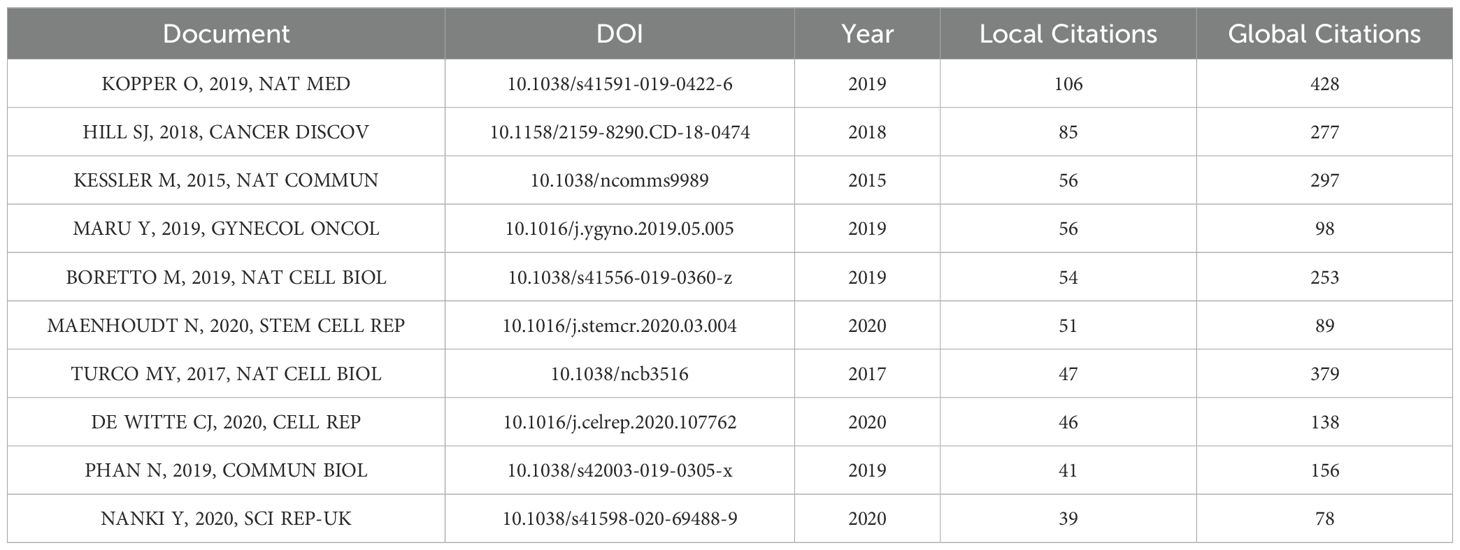- 1Department of Gynecology, Affiliated Renhe Hospital of China Three Gorges University, Yichang, China
- 2Department of Neurosurgery, The First Affiliated Hospital of Dalian Medical University, Dalian, Liaoning, China
Background: Gynecological cancers (GC) pose a severe threat to the health and safety of women’s lives, and organoids, as in-vitro research models, have demonstrated significant advantages in simulating tissue characteristics and drug screening. In recent years, there has been a rapid increase in research outcomes related to organoids in GC. However, there has been no bibliometric study concerning.
Methods: Publications related to GC and organoids from 2010-2023 were retrieved from the Web of Science Core Collection (WoSCC). We conducted a bibliometric analysis and visualization using CiteSpace, VOSviewer, and the Bibliometrix R Package. This analysis included the spatiotemporal distribution, author, sources, references, and keywords.
Results: A total of 333 publications were included. The number of annual publications indicated an explosive phase of development since 2019. The USA was the most important country in terms of cooperation, publication output, citation and centrality. University of California system ranked first in productivity among institutions, and HIPPO Y is the most relevant author in the research field. CANCERS published the most documents, and NATURE is the most cited sources. Analysis of Keywords and References, it is possible to establish the trend, and find the hotspots in the research field.
Conclusion: This bibliometric analysis delineated global landscapes and progress trends in GC organoids research. This study emphasized that organoids can effectively replicate the original tissue or tumors, providing a good in-vitro model for research on tumor-related mechanisms and showing significant advantages in drug screening and efficacy clinical prediction. Additionally, as preclinical models, they provide compelling evidence for personalized therapy and prediction of patient drug responses.
1 Introduction
Gynecological cancers(GC) represent a significant global health challenge due to their high prevalence and mortality rates (1, 2). The development of novel therapeutic strategies and early diagnostic tools is imperative to improve patient outcomes. In recent years, the advent of organoid technology has provided an ideal model in-vitro for cancer research (3). Organoids, as three-dimensional (3D) cell cultures that simulate the body’s tissues and organs in vitro (4), include multiple cell types (5) and can faithfully reproduce the histology, genetics, and mutational profiles of the source tissue (4, 6). They offer a versatile tool for diagnostics, disease modeling, drug discovery, and personalized medicine (6). In addition, organoids serve as clinical models for tumors, offering an ideal model for foundational and clinical studies and bridging the gap between in-vitro studies, animal models, and clinical treatment responses in patients (7, 8).
Despite the rapid growth of organoids research in GC, particularly in ovarian cancer (OC), endometrial cancer(EC) and cervical cancer(CC), a comprehensive assessment of the scientific output, trends, and current hotspots in this area remains largely unexplored. Bibliometric analysis, a quantitative method for mapping and evaluating scientific literature, provides a systematic approach to understanding the structure, development, and impact of research fields over time (9, 10).
The objective of this study is to conduct a bibliometric analysis of the scholarly literature pertaining to the utilization of organoids in GC research. By examining the publication trajectories, authorship dynamics, institutional collaborations, and thematic shifts, the research endeavors to map the landscape of organoid research in this field. Furthermore, the study seeks to identify the most influential studies, prominent researchers, and key institutions driving the advancement of organoid technology in GC. We will also analyze the thematic shifts and find the hotspots by examining the keywords and references associated with organoid studies in GC. This analysis will not only provide insights into the current state of research but also highlight potential areas for future investigation.
2 Methods
2.1 Data collection
The Web of Science (WoS) is globally acknowledged as a highly credible citation database, as affirmed by a distinguished publisher (11). To enhance the representative and accessible data, our search encompassed both the Web of Science Core Collection (WoSCC) database and the Science Citation Index Expanded (SCI-EXPANDED). Our search query integrated Medical Subject Headings (MeSH) terms and keywords of “Organoids” with “ Endometrial cancers” OR “Ovarian cancer” OR “Cervical Cancers”. We covered a period from January 1, 2010, to April 30, 2024. The data retrieved were collected on May 12, 2024, to mitigate any potential biases due to daily updates. A total of 391 records were initially identified, which were then narrowed down to articles (n=253) and reviews (n=80), all of which were in English. These records were exported in full-text format, inclusive of cited references. Two authors independently accomplished all literature searches, and the outcomes were compared. Any differences were discussed with a third author to establish which articles would be incorporated in the ultimate analysis.
2.2 Data analysis
VOSviewer (v.1.6.20), CiteSpace (v.6.3.R1 Basic), and the Bibliometrix R Package were utilized to analyze and visualize the entire collection of 333 documents. The emergence and development of these bibliometric analysis software significantly propelled research and expanded applications in the field of information visualization (9).
VOSviewer, the Visualization of Similarities viewer, is a Java-based free software developed by Van Eck and Waltman at the Centre for Science and Technology Studies (CWTS), Leiden University, in 2009, designed for constructing and visualizing bibliometric networks (12). We used VOSviewer software to analyze and visualize the citation sources relationships, as well as the co-occurrence network of keywords and references.
CiteSpace, developed by Professor Chaomei Chen at Drexel University, is a multifaceted, time-sensitive, and dynamic citation visualization analysis software that focuses on uncovering latent knowledge within scientific literature, evolving within the context of scientometrics and information visualization (11, 13, 14). By employing CiteSpace software, we analyzed and visualized the network of countries/regions and institutions, the institutions and references with the strongest citation bursts, and the dual-map overly of journals. It extracted the publication counts of the top 10 institutions and calculate the centrality values.
The Bibliometrix R Package, an open-source and free toolkit for scientometric analysis and visualization, was co-developed by Italian statisticians Massimo Aria and Corrado Cuccurullo (9, 15). Using the Bibliometrix R package to extract annual and cumulative publication counts, as well as publication volumes by country/region, author, and journal, and then displaying these data with bar charts using the R language. The tool displayed the cooperation between countries/regions with a chord diagram, and shown the top 10 authors’ publications and the trend topics of keywords over time with a line char. Figure 1 illustrates the flowchart of the search strategy and analysis process in this study.
3 Results
3.1 Global contribution to the field
According to the literature screening process (Figure 1), a total of 333 literatures were deemed suitable and included in the final analysis. From 2010 to 2024, the number of annual and cumulative publications was shown in Figure 2A. There was a significant increase in the number of publications from 2019 onwards. In 2018, there were less than 10 articles published per year, but this number rose to 85 articles in 2023. Furthermore, as of April 2024, 33 papers were published.
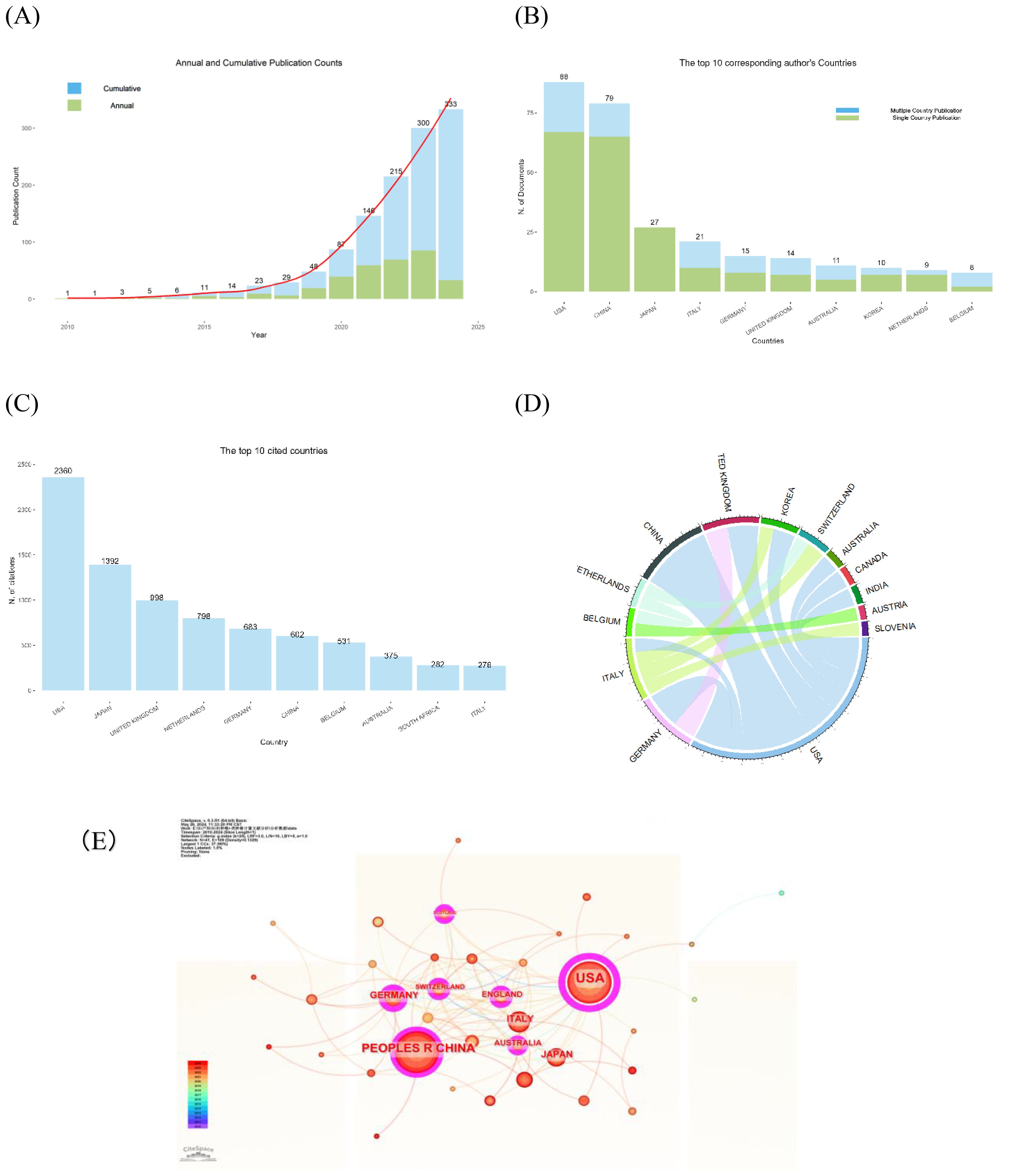
Figure 2. Global trends and country/region research contributions to organoids in GC. (A) Annual and Cumulative number of publications related to organoids in GC. (B) The top 10 Corresponding Author’s Countries (C) The top 10 Cited Countries/Region. (D) The international cooperation analysis (cooperation frequency > 2). The line between two countries/regions indicates cooperative relationship. (E) The network of countries/regions from CiteSpace. The size of the nodes represents the total number of publications for a country/region, with larger nodes indicating a greater number of articles, and the nodes have purple outer rings in the network representing high betweenness centrality which is the importance of location in a network of nodes.
Based on the analysis of corresponding authors’ countries by Bibliometrix R Package, we found that the United States of America (USA) had the largest number of articles (n=88, 26.4%), followed by China (n=79, 23.7%), Japan (n=27, 8.1%), and Italy (n=21, 6.3%) (Figure 2B). In addition, USA also collaborated with other countries or regions frequently with 21 papers (23.9%). In the citation statistics, the USA had the highest number of citations (n=2360), followed by Japan (n=1392) and the United Kingdom (n=998) (Figure 2C). Figure 2D illustrates the collaboration status in organoid research for GC using a chord diagram. In Figure 2E, CiteSpace was utilized to analyze the national network map. There were seven countries or regions such as USA, China, Germany, Switzerland, England, Australia, and Scotland, which play the importance of roles in the research field.
3.2 Analysis of authors and institutions
There was a total of 2,621 authors in the field of GC organoids, of which the average number of co-authors per Document was 9.81. We found that the top 10 authors in this field have published 75 papers, which account for 22.5% of all publications (Figure 3A). Additionally, Figure 3B shows the production of the top 10 relevant authors over time. A total of 10 papers published in this field by Hippo Y, spanning from 2019 to 2024, and Canzonieri V and Rizzolio F are co-authors of 9 articles, spanning 2020-2024. As of April 2024, the top five authors collectively published 10 papers in 2024, which accounts for 30.3% of the total publications (n=33). (shown in Table 1).
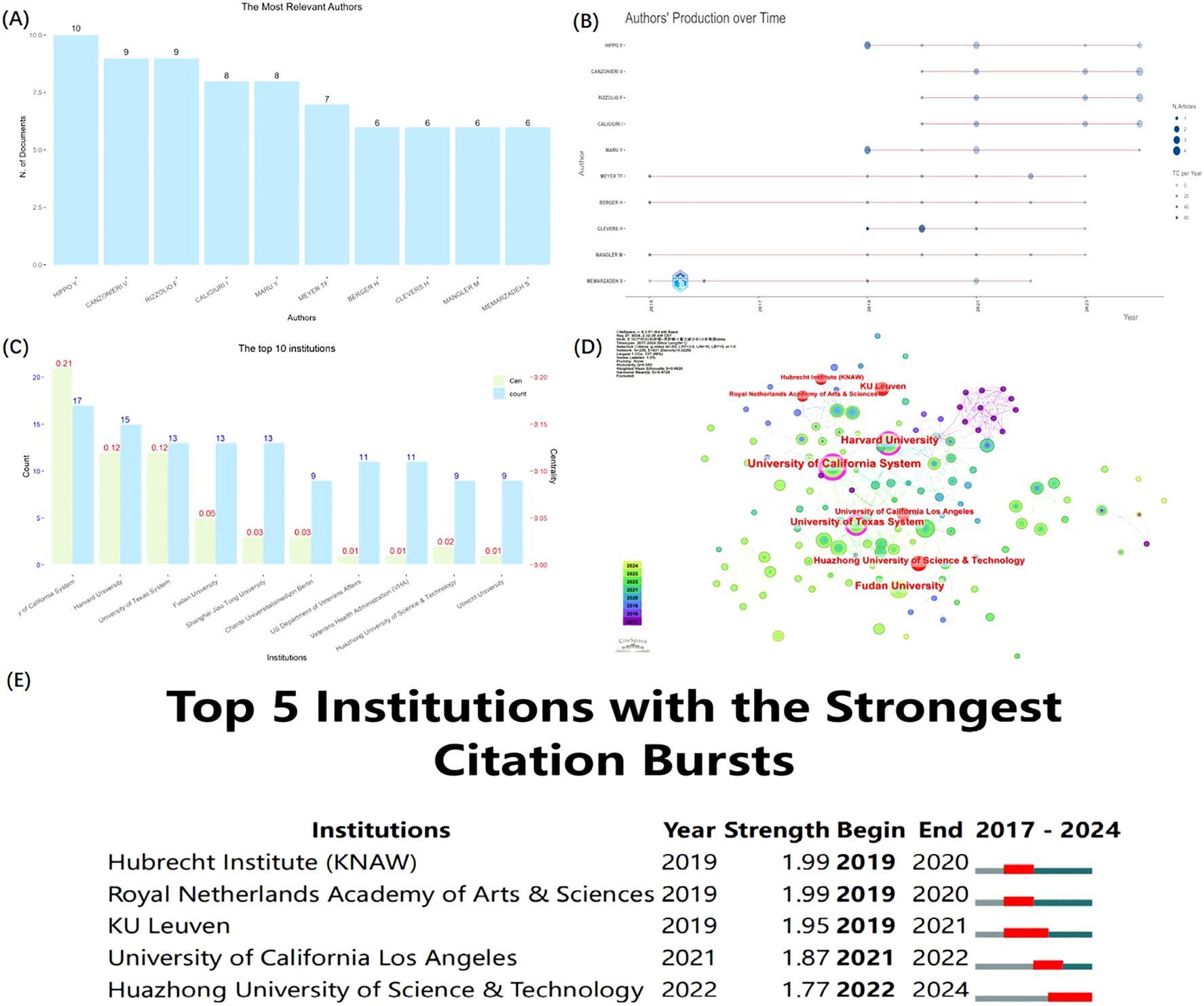
Figure 3. The distribution of authors and institutions in GC and organoids research. (A, B) The top 10 most relevant authors and authors’ production over time. (C) The top 10 institutions with counts and centrality. (D) The network of institutions from CiteSpace. (E) The Top 5 institutions with the strongest citation Bursts from CiteSpace.
The top 10 related institutions with the largest number of publications extracted by CiteSpace (Figure 3C). The University of California system had the highest number of publications (n=17) and the highest centrality value (0.21). Harvard University ranked second in the number of published documents (n=15), and both Harvard University and the University of Texas system ranked second in centrality value (0.12). In the network of relevant institutions, as shown in Figure 3D, a high centrality value indicates high betweenness centrality with purple outer rings. Additionally, based on the strongest citation bursts analysis (γ=0.8), the 5 nodes are shown in red in the network, which are Hubrecht Institute (KNAW), Royal Netherlands Academy of Arts & Sciences, KU Leuven, University of California Los Angeles, and Huazhong University of Science and Technology (HUST) (Figure 3E). What’s more, the citation bursts of HUST occurred in 2022-2024, indicating outstanding research in the field recently.
3.3 Analysis of active journals
The outcome in the research field of GC organoids were published in 169 journals. CANCERS ranked first (n=21), followed by INTERNATIONAL JOURNAL OF MOLECULAR SCIENCES (n=13), NATURE COMMUNICATIONS (n=9), FRONTIERS IN ONCOLOGY (n=8), and SCIENTIFIC REPORTS (n=8), as shown in Figure 4A. Meanwhile, Figure 4B is a network visualization of source analysis by VOSviewer. The relevant information of the top 10 key journals in this field is presented in Table 2.
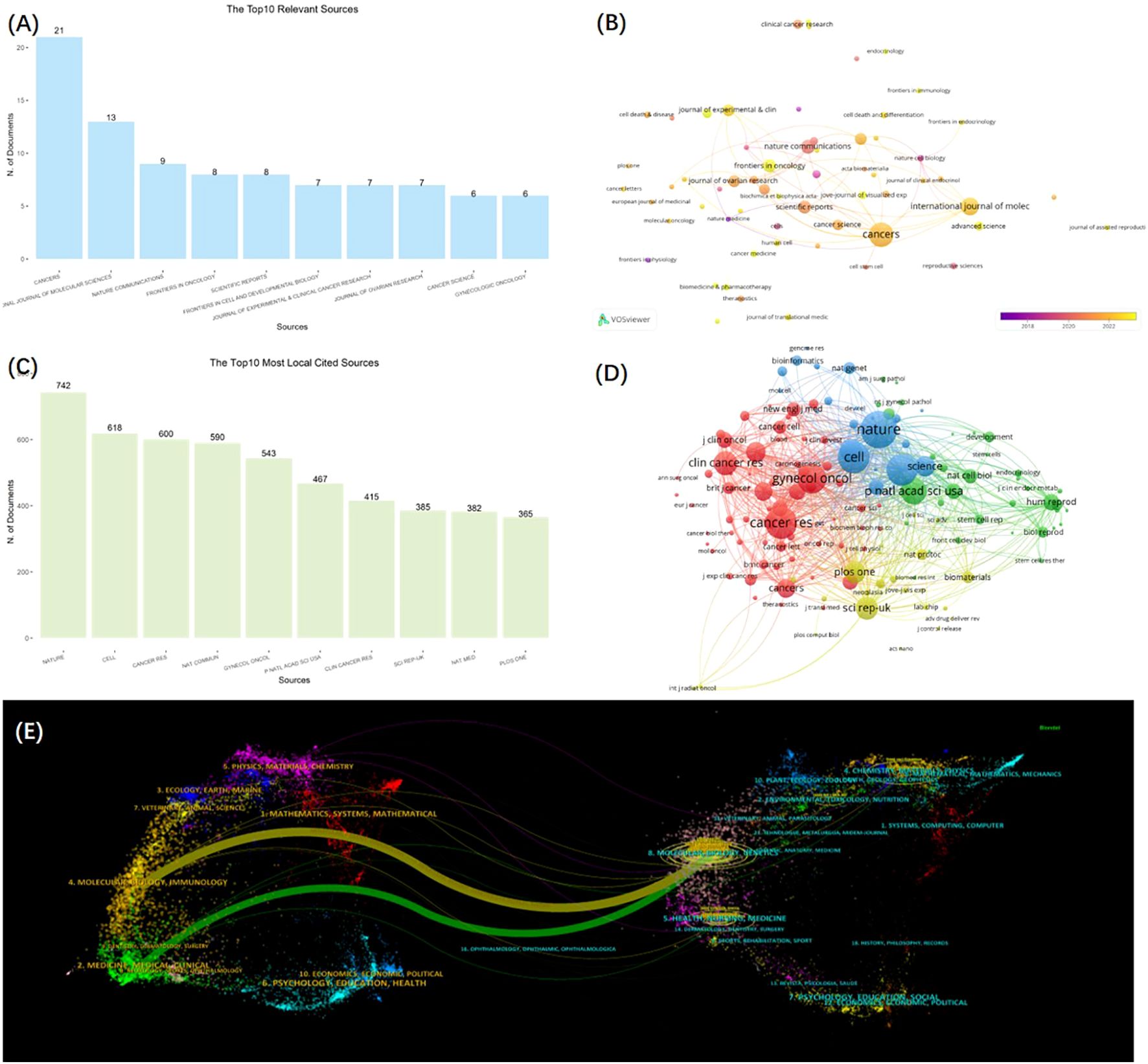
Figure 4. The distribution of authors and institutions in GC and organoids research. (A) The Top 10 most relevant sources. (B) Network visualization of sources analysis from VOSviewer. (C) The top 10 most local cited sources. (D) Network visualization of cited sources analysis from VOSviewer. (E) Dual-map overlay of journals from CiteSpace.
Then, we further analyzed the local cited source in the field and presented the top 10 major journals using a bar chart (Figure 4C) and the network of cited journals through VOSviewer analysis (Figure 4D). Rounding out the top 5 journals were NATURE (n = 742), CELL (n = 618), CANCER RESEARCH (n = 600), NATURE COMMUNICATIONS (n = 590), and GYNECOLOGIC ONCOLOGY (n = 543).
Figure 4E depicts the Dual-map overlay of journals by CiteSpace. The citing journals are on the left, the cited journals on the right, and the curve lines represent the citation path association of journals. Tow citation paths (orange and green) were recognized, indicating that the studies published in Molecular/Biology/Immunology journals (orange path) and Medicine/Medical/Clinical journals (green path) were cited by the research published in Molecular/Biology/Genetics journals.
3.4 Analysis of keywords
VOSviewer software was employed to construct a keyword co-occurrence network, facilitating the identification of emerging trends and hotspots within the research landscape of GC and organoids, as illustrated in Figure 5. This network analysis elucidated the interconnections and prominence of various research themes, offering a visual synopsis of the field’s intellectual structure and dynamics. We set the minimum number of keywords plus occurrences to 10, and 43 keywords plus meet the threshold. The nodes and font sizes in Figure 5A represent the frequency of the keywords and their importance in the field. The keywords were divided into 4 clusters.
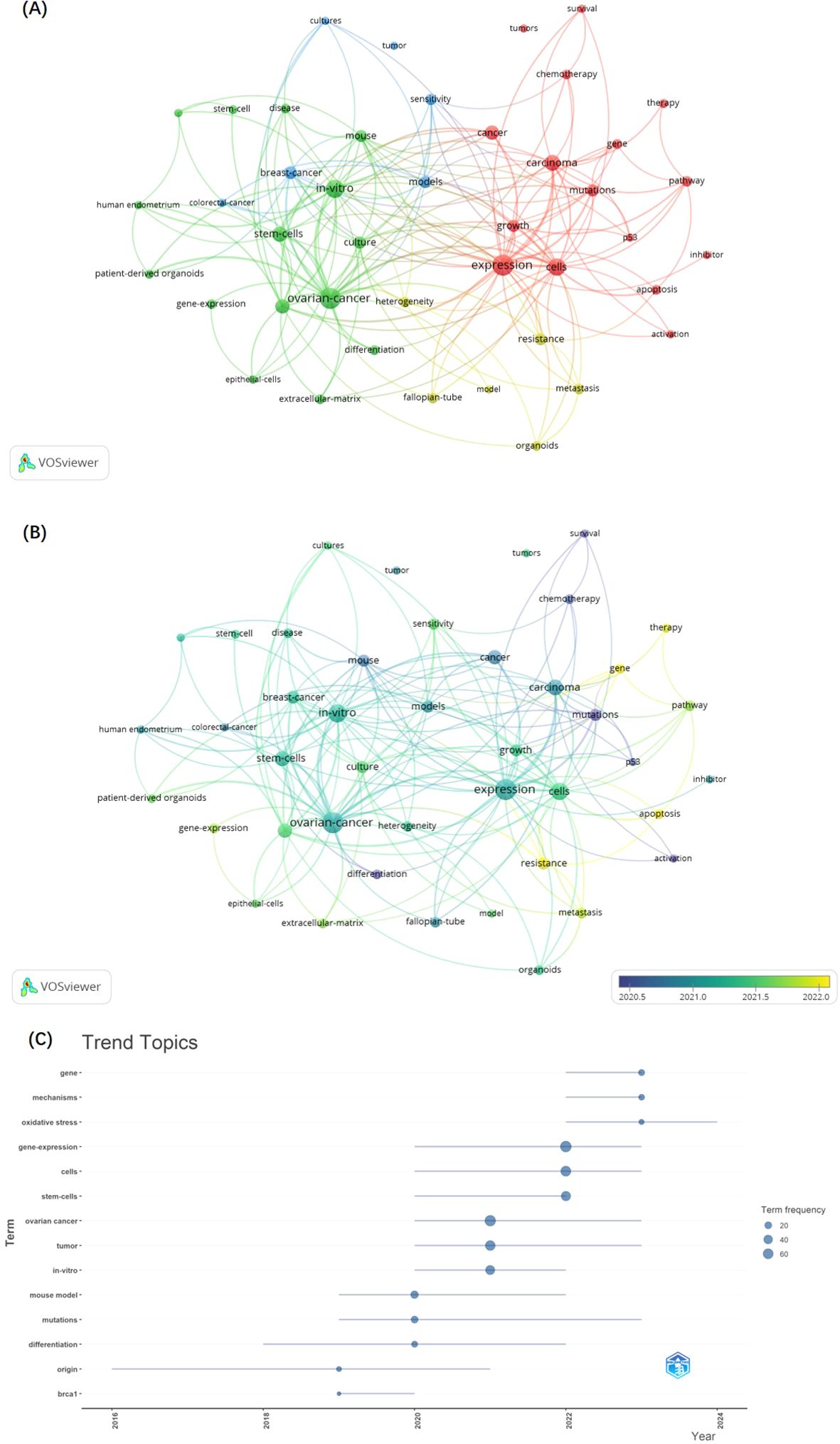
Figure 5. The network of keywords plus co-occurrence. (A) Overlay map of keyword according to clusters from VOSviewer. (B) The timestamp visualization of keywords from VOSviewer. (C) the trend topics of KeywordPlus from Bibliometrix R Package.
Cluster 1 includes keywords plus such as activation, apoptosis, cancer, carcinoma, cells, chemotherapy, expression, gene, growth, inhibitor, mutations, p53, pathway, survival, therapy, and tumors, indicating that this cluster may be related to the molecular and cellular mechanisms of cancer development and treatment.
In cluster 2, keywords such as culture, differentiation, disease, epithelial-cells, extracellular-matrix, gene-expression, human endometrium, in-vitro, long-term, long-term expansion, mouse, ovarian-cancer, patient-derived organoids, and stem-cells indicate that the text in this section focuses on issues related to in vitro cell biology and the study of organoids for modeling diseases and their long-term behavior.
Cluster 3 keywords included breast-cancer, colorectal-cancer, cultures, models, sensitivity, and tumor, suggesting that the texts represented by this cluster may be more focused on the development and application of cancer models for assessing drug sensitivity and therapeutic strategies.
Cluster 4 contains many cancer progression and heterogeneity keywords, such as fallopian-tube, heterogeneity, metastasis, model, organoids, and resistance, indicating that the text represented by this cluster is focused on the study of cancer metastasis, the use of organoids to model complex tumor characteristics, and the development of drug resistance.
As shown in Figure 5B, the keywords appearing in recent years, such as gene, therapy, apoptosis, resistance, and metastasis, were all related to advances in cancer development mechanistic and the challenges of drug resistance. The keywords analysis conducted using the Bibliometrix R Package, specifically the trend topics of keywords Plus (Figure 5C), corroborates the same conclusion. The focus within the trend topics has been on the most recent three keywords: gene, mechanisms, and oxidative stress, which are linked to the mechanistic research. Besides, the field of oncology research has been the focus of scholars and organoids as the pre-clinical models is associated with good research prospects.
3.5 Analysis of references and documents
A total of 18,205 references in the research field were cited. The co-citation network of 134 references cited over 10 times (Figure 6A) is constructed by the VOSviewer. The intensity reference citations are shown in Figure 6B, with brighter colours indicating more frequent citations.
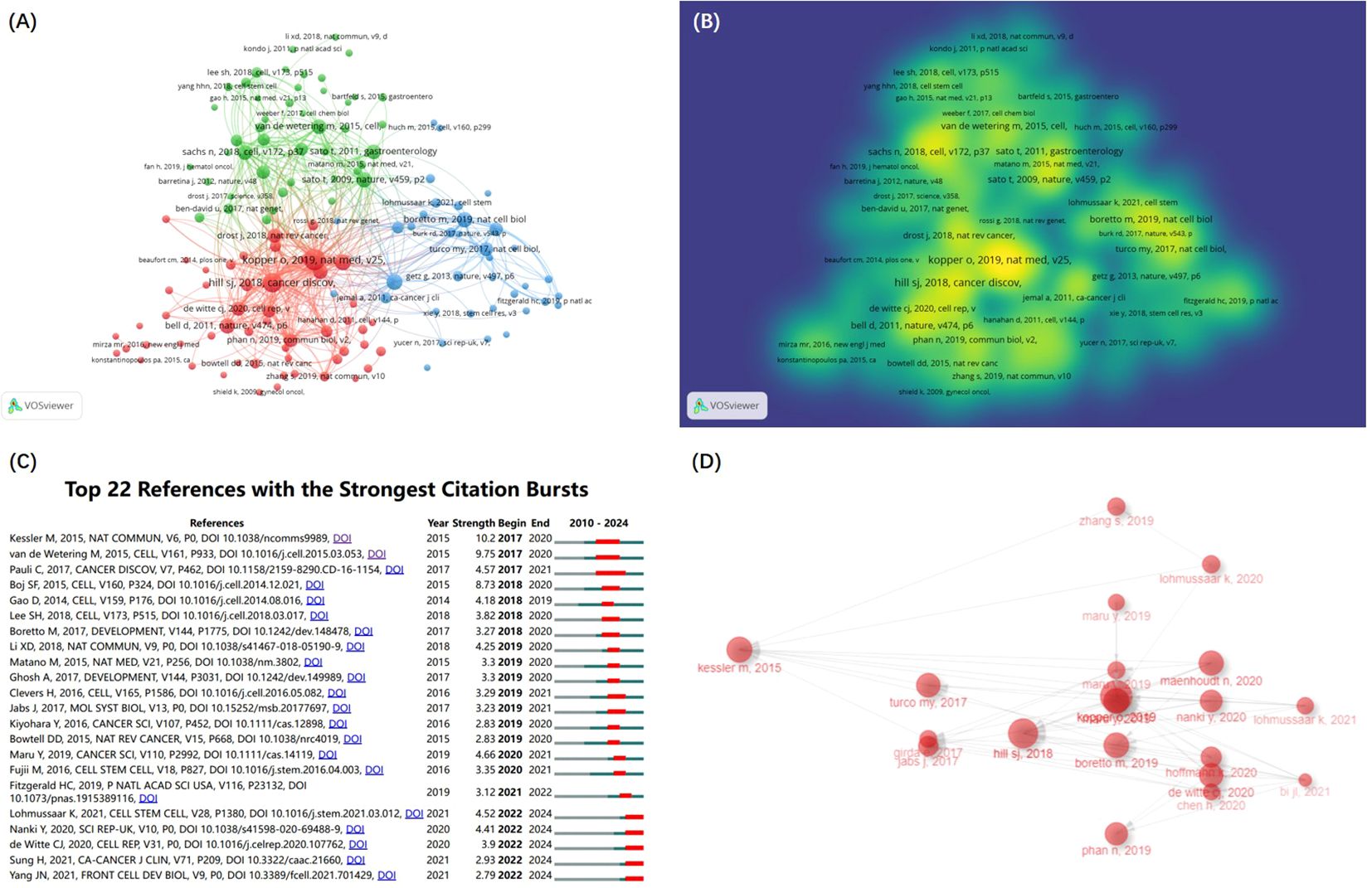
Figure 6. The references and documents analysis. (A) The co-citation network of references according to clusters from VOSviewer. (B) Density map of cocited analysis of references from VOSviewer. (C) Visualization map of the top 22 references with the strongest citation bursts from CiteSpace. (D) the Historiograph of the GC and organoids research from Bibliometrix R Package.
The burst detection algorithm invented by Kleinberg (16) of CiteSpace visualize the top 22 references with the strongest citation bursts (Figure 6C). There are 5 references with the citation bursts end in 2024 that reflect the most important reference in the field and identify emerging topics and research frontiers (9). Among the 5 references, 3 were associated with OC organoids research, and 1 CC.
Table 3 lists the top 10 cited references that form the foundation of GC organoids research. Among these 10 articles, 9 were associated with organoids research, and 4 were from the OC research.
In addition, the top 10 local cited documents is listed in Table 4 that also represent the most important research literature in the field. what’s more, based on the Bibliometrix R Package, we obtained the Historiograph map, featuring 20 pivotal, highly-cited documents in the GC and organoids (Figure 6D), which afford a general overview of the progress and knowledge base. This field mainly studies the establishment of organoids, their advantages as preclinical models and drug screening, and is more interested in OC.
4 Discussion
4.1 General information
This study conducted a comprehensive bibliometric analysis of the literature in the research of GC and organoids, utilizing advanced analytical and visualization tools such as CiteSpace, VOSviewer, and the Bibliometrix R Package. The analysis encompassed global research trends, including the number of publications, contributing countries or regions, institutions, authors, journals, keywords, and references. A total of 333 documents were retrieved from the WoSCC, spanning the period from 2010 to 2024, and these literatures were disseminated across 169 journals by 2,621 authors affiliated with 681 institutions in 41 countries or regions.
The bibliometric analysis revealed a marked increase in the number of publications on GC and organoids since 2019. A statistical examination of publication outputs by various countries and institutions has identified leading nations and research entities with significant contributions to the field. The US, China, and Japan have emerged as major contributors to organoids research in GC, and US, Japan, and the United Kingdom demonstrate advanced maturity in this domain. CiteSpace analysis identified the top 10 institutions with five from the United States, three from China, one from the Netherlands, and one from Germany. Notably, the University of California exhibited the highest count and betweenness centrality values, indicating its pivotal role. Enhanced collaboration and communication among these entities are essential for surmounting academic silos and propelling forward the field of GC and organoids research.
In the hierarchy of the most relevant authors in the field of GC organoids, Dr. Hippo Y leads with the highest publication count (10, 3%), followed by Drs. Canzonieri V (9, 2.7%) and Rizzolio F (9, 2.7%). In recent years, they continued to research in the field, and 6 articles have been published by them in 2024(n=33). Despite this, the author analysis by CiteSpace did not identify any author with a centrality score above the threshold of 0.10, denoting no authors with significant influence in the field.
Through an analysis of the publication outlets, it has been determined that the journal with the highest number of publications in the field of GC and organoids is CANCERS, accounting for 21 articles (6.3%). Among the TOP10 Most Relevant Sources, two journals have an impact factor exceeding 10 for the year 2023: NATURE COMMUNICATIONS with an impact factor of 14.7 and JOURNAL OF EXPERIMENTAL & CLINICAL CANCER RESEARCH 11.4. In the citation analysis, the most frequently cited sources are NATURE with 742 citations, CELL with 618, and CANCER RESEARCH with 600. The distribution of sources and citations is instrumental in identifying the core journals for publishing research related to GC organoids, thereby aiding scholars in establishing scientific achievements. These data will be valuable for future scholars when selecting appropriate journals for the submission of related manuscripts.
4.2 Analysis of key documents
To rapidly grasp the key documents in GC Organoids field, we can utilize the Bibliometrix-R-package for Document analysis to construct a Historiograph (Figure 6D) that includes the top 20 documents with the most local citations in this field. Analysis of the key documents reveals that the primary focus has been on three aspects: the construction of organoids, their characteristics, and their application as clinical models.
4.2.1 Construction of gynecological cancer organoids
GC organoids possess advantages such as high success rates, low costs, and the preservation of tumor heterogeneity (17). They can also maintain long-term propagation (18). Most importantly, organoids can be successfully established in short periods (19–23), and the tissues required for their creation are easily accessible. In addition to the primary tumor, they can also be derived from malignant effusions (21) and cervical brushings (24). In the research on the construction process of organoids, signals that affect the continuous expansion of organoids include Wnt (25, 26) and Notch (26), and NRG1 is identified as a key factor for the growth of OC organoids (27).
Researchers have improved organoid generation and assessment techniques in recent year. Matrigel bilayer organoid culture (MBOC) protocol can enhance the efficiency of organoid culture (28). Organoids via a 3D ring-shaped model enable rapid high-throughput screenings and preserving original histological features, which are suitable for clinical decision-making (20). The DeathPro, an automated microscopy-based assay, can identify cell death induced by drugs and inhibition of proliferation, elucidating genotype-drug sensitivity correlations (29).
4.2.2 Characteristics of GC organoids
It has been found that organoids replicate the histological, genomic, and mutational characteristics of the original tumor or tissue (18, 19, 25, 27, 28, 30–34), while also exhibiting genetic diversity and heterogeneity both intra- and inter-patient (33). The heterogeneity between patients (32) aids in using organoids as ideal models for personalized therapy. Diverse organoids clone derived from distinct tumor regions highlight inter-clonal heterogeneity within patients (28), which contributes to the study of tumor complexity. Moreover, studies have shown that Organoids display inter- and intrapatient drug response heterogeneity, partly explained by genetic aberrations (22).
4.2.3 Application of GC organoids
Organoids serve as valuable clinical models in drug screening, effectively emulating the reactions of original tumor (19–22, 27, 28, 30, 32–34). They also function as clinical models to research tumor origin (35, 36). Furthermore, organoids are utilized as clinical models for genetic manipulation and other related research. Hill, SJ, et al. employed organoids derived from OC to assess DNA repair and evaluate treatment sensitivity (31). Lohmussaar et al. suggested that healthy ecto- and endocervical 3D organoid cultures could open exciting new avenues for studying CC and infections (24).
The key documents analysis helps researchers quickly understand the key points in the research field of GC organoids.
4.3 Hotspots and frontiers
In bibliometric analysis, through keyword co-occurrence and clustering analysis, trends in research themes and current hotspots are identified (37, 38). In the GC organoids field, the current hotspots are the use of organoids as clinical models to investigate tumorigenesis and drug resistance mechanisms. As a model for GC research, organoids are extensively utilized in OC, CC, and EC. Notably, organoids of OC have been particularly well-studied, with prominent research hotspots. OC emerges as one of the important keywords in this analysis. Thus, the following discussion will center on OC organoids to explore the current research frontiers and hotspots in this field.
Organoids, as tumor research models, can more accurately simulate in-vivo tumor growth (39). They not only faithfully represent the pathological and genetic characteristics of the original tumor (40), but also, through the diversity of their genetic features and the application of genetic manipulation techniques, provide a valuable platform for research into tumor mechanisms and drug development. Next, we will discuss the current state of research in two aspects: the diversity of genetic characteristics in organoids and the alteration of gene expression.
4.3.1 Diversity of genetic characteristics in organoids
By comparing the diversity of Organoids and integrating this with clinical information and drug response features of patients, it becomes easier to explore the complex mechanisms of action and resistance analysis of tumors. Al-Alem et al. constructed patient-derived organoids (PDOs) from four different patients as experimental models and found that different organoids exhibited dose-dependent responses to anti-Sialyl Tn antibody-drug conjugate (anti-STn-ADC), explained by the different level of Sialyl Tn(STn) (41). Miao et al. grouped PDOs based on different Ferroptosis suppressor protein 1 (FSP1) expression levels and discovered that FSP1 is a prognostic indicator for OC patients, and that olaparib and iFSP1 (a FSP1 inhibitor) inhibit the proliferation of OC-PDOs, but the effect is not due to ferroptosis (42). Gao et al. validated the drug effect by grouping PDOs based on the glutamine metabolism prognostic index (GMPI) and found that GMPI can serve as a reliable prognostic indicator for patients and help optimize treatment strategies (43). Cai et al. found that organoids derived from different patients exhibited different drug responses (resistant or sensitive to cisplatin), and further analysis of the different drug response groups revealed differences in senescence-associated genes (SGK1, VEGFA) (44). Trillsch et al. suggested that organoids constructed from different disease stages (untreated primary tumors, advanced tumors, recurrent tumors) provide the possibility for direct comparative analysis (45). Organoids can be generated from cells that are poorly represented in the biopsy, thereby enabling the selection of particular tumor molecular traits (40), which further enriches the genetic phenotype diversity of organoids and offers more possibilities for the study of related mechanisms.
4.3.2 Modulating gene expression in organoids
In the investigation of their mechanisms, it is possible not only to study via the diversity of genes expression within Organoids but also to manipulate the expression of specific genes through genetic engineering techniques to observe their effects on pathogenesis and drug sensitivity. Zhang et al. constructed organoids resistant to platinum-based drugs from OC tumor cells derived from ascites, and by combining use of si-ZDHHC12 and cisplatin, they observed changes in the drug resistance of organoids while affecting the expression level of ZDHHC12, finding that the inhibition of ZDHHC12 can enhance the antitumor activity of cisplatin in OC (46). Wang et al., to explore the mechanism of circ-RAD23B in organoids, controlled the expression level of circ-RAD23B by transfecting pLV-circRAD23B and sh-circRAD23B into PDOs, and observed the proliferative capacity, apoptosis levels, and carboplatin resistance of PDOs, showing that the level of circRAD23B expression can modulate the sensitivity or resistance of PDOs to carboplatin (39). Dai et al. created organoids from primary human normal fallopian tube epithelial (FTE) and introduced TP53 and RAD51D knockdown organoids to explore their impact on mutations arising from FTE damage, emphasizing that the use of FTE organoids with RAD51D mutations can serve as a valuable in-vitro platform for early detection of carcinogenic effects, mechanism exploration, and drug screening (47). Gong et al. discovered that different sources of PDOs showed varying chemosensitivity to epithelial ovarian cancer (EOC), and that Zinc finger SWIM-type containing 4 (ZSWIM4) inhibition can enhance the chemosensitivity of EOC cells by improving intracellular glycine metabolism reprogramming (48).
OC, particularly high-grade serous carcinoma (HGSOC), continues to pose a significant threat to public health, with BRCA mutations and Homologous Recombination (HRD) status being pivotal in the diagnostic and therapeutic for OC (49). Organoids, when employed as clinical models for HRD assessment, contribute significantly to the prediction of patient response to therapy (49, 50). PDOs offer a treasure trove of opportunities for exploring tumor mechanisms and drug research. Despite the current limitations associated with the lack of a tumor microenvironment in organoids (8), there is considerable anticipation for the potential of organoids in cancer research. Organoids are regarded as promising tools for precision oncology and are seen as invaluable platforms for biological and pharmacological research (40, 51).
4.4 Limitations
Firstly, this study retrieved documents from the WoSCC database with restrictions on document types and languages, which may have resulted in the exclusion of some relevant literature. Additionally, while some documents were included based on keyword searches that met the retrieval criteria, there is a possibility that documents whose content does not align with the research topic were still included. Therefore, it is essential to establish a rigorous search strategy to ensure the comprehensiveness and reliability of the input data. Secondly, although bibliometric software such as CiteSpace and VOSViewer can quickly analyze relevant literature, they provide only metadata rather than the full text, which may lead to biases or omissions in the analysis results. Thirdly, given the continuous updating of databases, both the number of retrieved documents and the citation counts of obtained documents are in a state of constant flux, which may result in discrepancies between the results and the most recent research. These limitations may slightly affect the overall results; however, the primary objective of bibliometric analysis is to focus on the main trends and hotspots in a field through the analysis of a large volume of literature data. Overall, our study provides a foundation for understanding the research themes, hotspots, and development trends of organoids and GC.
5 Conclusion
Through a detailed bibliometric analysis of Organoids and GC, this study assessed the literature information across various years, countries, institutions, authors, disciplines, and journals, and analyzed the development of topics and potential future research hotspots. Our research observed that the field began to receive focused attention in 2019, with a rapid increase in research outcomes. Our study provides fundamental information on research in this field and identifies potential collaborators for interested researchers. In this domain, Organoids, as in vitro models for GC research, not only allow for the establishment of models with a small amount of tissue in a short time but also stably replicate the histological and genetic characteristics of the original tumor. They are manipulable for exploring the mechanisms of disease occurrence and progression. Additionally, as preclinical models, they provide compelling evidence for personalized therapy and prediction of patient drug responses.
Data availability statement
The original contributions presented in the study are included in the article/supplementary material. Further inquiries can be directed to the corresponding author.
Ethics statement
Given that the current study utilized publicly accessible and de-identified data from investigations that had previously obtained ethical committee approval, thereby eliminating the requirement for subsequent ethical clearance.
Author contributions
BH: Conceptualization, Data curation, Formal Analysis, Methodology, Project administration, Writing – original draft, Writing – review & editing. HM: Data curation, Formal Analysis, Methodology, Software, Visualization, Writing – original draft. HY: Data curation, Methodology, Writing – review & editing. DL: Software, Visualization, Writing – original draft. LZ: Writing – review & editing. JW: Conceptualization, Project administration, Writing – review & editing, Funding acquisition.
Funding
The author(s) declare that financial support was received for the research, authorship, and/or publication of this article. This work was supported by the National Natural Science Foundation of China [grant number 81302269] and by Open Research Topics of the National Key Laboratory of Ultrasonic Medical Engineering [grant number 2023KFKT010].
Conflict of interest
The authors declare that the research was conducted in the absence of any commercial or financial relationships that could be construed as a potential conflict of interest.
Publisher’s note
All claims expressed in this article are solely those of the authors and do not necessarily represent those of their affiliated organizations, or those of the publisher, the editors and the reviewers. Any product that may be evaluated in this article, or claim that may be made by its manufacturer, is not guaranteed or endorsed by the publisher.
References
1. Shrestha P, Poudyal B, Yadollahi S, W DE, G AV, W JD, et al. A systematic review on the use of artificial intelligence in gynecologic imaging - Background, state of the art, and future directions. Gynecol Oncol. (2022) 166:596–605. doi: 10.1016/j.ygyno.2022.07.024
2. Wang YL, Gao S, Xiao Q, Li C, Grzegorzek M, Zhang YY, et al. Role of artificial intelligence in digital pathology for gynecological cancers. Comput Struct Biotechnol J. (2024) 24:205–12. doi: 10.1016/j.csbj.2024.03.007
3. Yang YJ, Kong YJ, Cui JL, Hou Y, Gu ZJ, Ma CQ. Advances and applications of cancer organoids in drug screening and personalized medicine. Stem Cell Rev Rep. (2024) 20:1213–26. doi: 10.1007/s12015-024-10714-6
4. Gómez-Alvarez M, Agustina-Hernández M, Francés-Herrero E, Rodríguez-Eguren A, Bueno-Fernandez C, Cervelló. Addressing key questions in organoid models: who, where, how, and why? Int J Mol Sci. (2023) 24:16014. doi: 10.3390/ijms242116014
5. Soto-Gamez A, Gunawan JP, Barazzuol L, Pringle S, Coppes RP. Organoid-based personalized medicine: from tumor outcome prediction to autologous transplantation. Stem Cells. (2024) 42:499–508. doi: 10.1093/stmcls/sxae023
6. Zhao Z, Chen X, Dowbaj AM, Sljukic A, Bratlie K, Lin L, et al. Organoids. Nat Rev Methods Primers. (2022) 2:94. doi: 10.1038/s43586-022-00174-y
7. Drost J, Clevers H. Organoids in cancer research. Nat Rev Cancer. (2018) 18:407–18. doi: 10.1038/s41568-018-0007-6
8. Nero C, Vizzielli G, Lorusso D, Cesari E, Daniele G, Loverro M, et al. Patient-derived organoids and high grade serous ovarian cancer: from disease modeling to personalized medicine. J Exp Clin Cancer Res. (2021) 40:116. doi: 10.1186/s13046-021-01917-7
9. Li J, Zhang L, Huang Y. Handbook of Scientometrics. BeiJing: Capital University of Economics and Business Press (2024).
10. Xu C, Li X. Trends and frontiers of maintenance therapy for ovarian cancer over the past 20 years: a bibliometric analysis. Future Oncol. (2024), 1–18. doi: 10.1080/14796694.2024.2357378
11. Liu X, Zhao S, Tan L, Tan Y, Wang Y, Ye Z, et al. Frontier and hot topics in electrochemiluminescence sensing technology based on CiteSpace bibliometric analysis. Biosens Bioelectron. (2022) 201:113932. doi: 10.1016/j.bios.2021.113932
12. van Eck NJ, Waltman L. Software survey: VOSviewer, a computer program for bibliometric mapping. Scientometrics. (2010) 84:523–38. doi: 10.1007/s11192-009-0146-3
13. Chen C. A glimpse of the first eight months of the COVID-19 literature on microsoft academic graph: themes, citation contexts, and uncertainties. Front Res Metr Anal. (2020) 5:607286. doi: 10.3389/frma.2020.607286
14. Chen C. Searching for intellectual turning points: progressive knowledge domain visualization. Proc Natl Acad Sci U S A. (2004) 101 Suppl 1:5303–10. doi: 10.1073/pnas.0307513100
15. Aria M, Cuccurullo C. bibliometrix: An R-tool for comprehensive science mapping analysis. J Informetrics. (2017) 11:959–75. doi: 10.1016/j.joi.2017.08.007
16. Xu S, Xu D, Wen L, Zhu C, Yang Y, Han S, et al. Integrating unified medical language system and Kleinberg's burst detection algorithm into research topics of medications for post-traumatic stress disorder. Drug Des Devel Ther. (2020) 14:3899–913. doi: 10.2147/DDDT.S270379
17. Maru Y, Hippo Y. Current status of patient-derived ovarian cancer models. Cells. (2019) 8:505. doi: 10.3390/cells8050505
18. Turco MY, Gardner L, Hughes J, Cindrova-Davies T, Gomez MJ, Farrell L, et al. Long-term, hormone-responsive organoid cultures of human endometrium in a chemically defined medium. Nat Cell Biol. (2017) 19:568–+. doi: 10.1038/ncb3516
19. Nanki Y, Chiyoda T, Hirasawa A, Ookubo A, Itoh M, Ueno M, et al. Patient-derived ovarian cancer organoids capture the genomic profiles of primary tumours applicable for drug sensitivity and resistance testing. Sci Rep. (2020) 10:12581. doi: 10.1038/s41598-020-69488-9
20. Phan N, Hong JJ, Tofig B, Mapua M, Elashoff D, Moatamed NA, et al. A simple high-throughput approach identifies actionable drug sensitivities in patient-derived tumor organoids. Commun Biol. (2019) 2:78. doi: 10.1038/s42003-019-0305-x
21. Chen H, Gotimer K, De Souza C, Tepper CG, Karnezis AN, Leiserowitz GS, et al. Short-term organoid culture for drug sensitivity testing of high-grade serous carcinoma. Gynecologic Oncol. (2020) 157:783–92. doi: 10.1016/j.ygyno.2020.03.026
22. de Witte CJ, Valle-Inclan JE, Hami N, Lohmussaar K, Kopper O, Vreuls CPH, et al. Patient-derived ovarian cancer organoids mimic clinical response and exhibit heterogeneous inter- and intrapatient drug responses. Cell Rep. (2020) 31:107762. doi: 10.1016/j.celrep.2020.107762
23. Bi JL, Newtson AM, Zhang YP, Devor EJ, Samuelson MI, Thiel KW, et al. Successful patient-derived organoid culture of gynecologic cancers for disease modeling and drug sensitivity testing. Cancers. (2021) 13:2901. doi: 10.3390/cancers13122901
24. Lohmussaar K, Oka R, Valle-Inclan JE, Smits MHH, Wardak H, Korving J, et al. Patient-derived organoids model cervical tissue dynamics and viral oncogenesis in cervical cancer. Cell Stem Cell. (2021) 28:1380–+. doi: 10.1016/j.stem.2021.03.012
25. Hoffmann K, Berger H, Kulbe H, Thillainadarasan S, Mollenkopf HJ, Zemojtel T, et al. Stable expansion of high-grade serous ovarian cancer organoids requires a low-Wnt environment. EMBO J. (2020) 39:e104013. doi: 10.15252/embj.2019104013
26. Kessler M, Hoffmann K, Brinkmann V, Thieck O, Jackisch S, Toelle B, et al. The Notch and Wnt pathways regulate stemness and differentiation in human fallopian tube organoids. Nat Commun. (2015) 6:8989. doi: 10.1038/ncomms9989
27. Maenhoudt N, Defraye C, Boretto M, Jan Z, Heremans R, Boeckx B, et al. Developing organoids from ovarian cancer as experimental and preclinical models. Stem Cell Rep. (2020) 14:717–29. doi: 10.1016/j.stemcr.2020.03.004
28. Maru Y, Tanaka N, Itami M, Hippo Y. Efficient use of patient-derived organoids as a preclinical model for gynecologic tumors. Gynecologic Oncol. (2019) 154:189–98. doi: 10.1016/j.ygyno.2019.05.005
29. Jabs J, Zickgraf FM, Park J, Wagner S, Jiang XQ, Jechow K, et al. Screening drug effects in patient-derived cancer cells links organoid responses to genome alterations. Mol Syst Biol. (2017) 13:955. doi: 10.15252/msb.20177697
30. Girda E, Huang EC, Leiserowitz GS, Smith LH. The use of endometrial cancer patient-derived organoid culture for drug sensitivity testing is feasible. Int J Gynecological Cancer. (2017) 27:1701–7. doi: 10.1097/IGC.0000000000001061
31. Hill SJ, Decker B, Roberts EA, Horowitz NS, Muto MG, Worley MJ, et al. Prediction of DNA repair inhibitor response in short-term patient-derived ovarian cancer organoids. Cancer Discovery. (2018) 8:1404–21. doi: 10.1158/2159-8290.CD-18-0474
32. Boretto M, Maenhoudt N, Luo XL, Hennes A, Boeckx B, Bui B, et al. Patient-derived organoids from endometrial disease capture clinical heterogeneity and are amenable to drug screening. Nat Cell Biol. (2019) 21:1041–+. doi: 10.1038/s41556-019-0360-z
33. Kopper O, de Witte CJ, Lohmussaar K, Valle-Inclan JE, Hami N, Kester L, et al. An organoid platform for ovarian cancer captures intra- and interpatient heterogeneity. Nat Med. (2019) 25:838–+. doi: 10.1038/s41591-019-0422-6
34. Maru Y, Tanaka N, Ebisawa K, Odaka A, Sugiyama T, Itami M, et al. Establishment and characterization of patient-derived organoids from a young patient with cervical clear cell carcinoma. Cancer Science. (2019) 110:2992–3005. doi: 10.1111/cas.v110.9
35. Zhang S, Dolgalev I, Zhang T, Ran H, Levine DA, Neel BG. Both fallopian tube and ovarian surface epithelium are cells-of-origin for high-grade serous ovarian carcinoma. Nat Commun. (2019) 10:5367. doi: 10.1038/s41467-019-13116-2
36. Lohmussaar K, Kopper O, Korving J, Begthel H, Vreuls CPH, van Es JH, et al. Assessing the origin of high-grade serous ovarian cancer using CRISPR-modification of mouse organoids. Nat Commun. (2020) 11:2660. doi: 10.1038/s41467-020-16432-0
37. Guo S, Wang L, Xie Y, Luo X, Zhang S, Xiong L, et al. Bibliometric and visualized analysis of stem cells therapy for spinal cord injury based on web of science and citeSpace in the last 20 years. World Neurosurg. (2019) 132:e246–e58. doi: 10.1016/j.wneu.2019.08.191
38. Perianes-Rodriguez A, Waltman L, van Eck NJ. Constructing bibliometric networks: A comparison between full and fractional counting. J Informetrics. (2016) 10:1178–95. doi: 10.1016/j.joi.2016.10.006
39. Wang H, Zhang YS, Miao HX, Xu T, Nie XL, Cheng WJ. CircRAD23B promotes proliferation and carboplatin resistance in ovarian cancer cell lines and organoids. Cancer Cell Int. (2024) 24:42. doi: 10.1186/s12935-024-03228-1
40. Cesari E, Ciucci A, Pieraccioli M, Caggiano C, Nero C, Bonvissuto D, et al. Dual inhibition of CDK12 and CDK13 uncovers actionable vulnerabilities in patient-derived ovarian cancer organoids. J Exp Clin Cancer Res. (2023) 42:126. doi: 10.1186/s13046-023-02682-5
41. Al-Alem L, Prendergast JM, Clark J, Zarrella B, Zarrella DT, Hill SJ, et al. Sialyl-Tn serves as a potential therapeutic target for ovarian cancer. J Ovarian Res. (2024) 17:71. doi: 10.1186/s13048-024-01397-1
42. Miao HX, Meng HY, Zhang YS, Chen T, Zhang L, Cheng WJ. FSP1 inhibition enhances olaparib sensitivity in BRCA-proficient ovarian cancer patients via a nonferroptosis mechanism. Cell Death Differentiation. (2024) 31:497–510. doi: 10.1038/s41418-024-01263-z
43. Gao LL, Wei Z, Ying FQ, Huang L, Zhang JN, Sun S, et al. Glutamine metabolism prognostic index predicts tumour microenvironment characteristics and therapeutic efficacy in ovarian cancer. J Cell Mol Med. (2024) 28:e18198. doi: 10.1111/jcmm.18198
44. Cai XT, Li YH, Zheng JF, Liu L, Jiao ZC, Lin J, et al. Modeling of senescence-related chemoresistance in ovarian cancer using data analysis and patient-derived organoids. Front Oncol. (2024) 13. doi: 10.3389/fonc.2023.1291559
45. Trillsch F, Reichenbach J, Czogalla B, Kraus F, Burges A, Mahner S, et al. Strategy for biobanking of ovarian cancer organoids: addressing the interpatient heterogeneity across histological subtypes and disease stages. Jove-Journal Visualized Experiments. (2024) 204:e66467. doi: 10.3791/66467
46. Zhang XN, Liao XM, Wang M, Liu J, Han JX, An D, et al. Inhibition of palmitoyltransferase ZDHHC12 sensitizes ovarian cancer cells to cisplatin through ROS-mediated mechanisms. Cancer Science. (2024) 115:1170–83. doi: 10.1111/cas.v115.4
47. Dai Y, Xu J, Gong X, Wei J, Gao Y, Chai R, et al. Human fallopian tube-derived organoids with TP53 and RAD51D mutations recapitulate an early stage high-grade serous ovarian cancer phenotype in vitro. Int J Mol Sci. (2024) 25:886. doi: 10.3390/ijms25020886
48. Gong KX, Huang YE, Zheng YQ, Hao WB, Shi K. ZSWIM4 inhibition improves chemosensitivity in epithelial ovarian cancer cells by suppressing intracellular glycine biosynthesis. J Trans Med. (2024) 22:192. doi: 10.1186/s12967-024-04980-8
49. Arcieri M, Tius V, Andreetta C, Restaino S, Biasioli A, Poletto E, et al. How BRCA and homologous recombination deficiency change therapeutic strategies in ovarian cancer: a review of literature. Front Oncol. (2024) 14:1335196. doi: 10.3389/fonc.2024.1335196
50. Arcieri M, Andreetta C, Tius V, Zapelloni G, Titone F, Restaino S, et al. Molecular biology as a driver in therapeutic choices for ovarian cancer. Int J Gynecol Cancer. (2024) 0:1–11. doi: 10.1136/ijgc-2024-005700
Keywords: gynecological cancers (GC), organoids, bibliometric analysis, ovarian cancer (OC), endometrial cancer (EC), cervical cancer (CC)
Citation: He B, Ma H, Yu H, Li D, Zhang L and Wang J (2024) Organoids research progress in gynecological cancers: a bibliometric analysis. Front. Oncol. 14:1484074. doi: 10.3389/fonc.2024.1484074
Received: 21 August 2024; Accepted: 07 October 2024;
Published: 28 October 2024.
Edited by:
Giuseppe Vizzielli, University of Udine, ItalyReviewed by:
Martina Arcieri, Ospedale Santa Maria della Misericordia di Udine, ItalyRita Trozzi, Agostino Gemelli University Polyclinic (IRCCS), Italy
Copyright © 2024 He, Ma, Yu, Li, Zhang and Wang. This is an open-access article distributed under the terms of the Creative Commons Attribution License (CC BY). The use, distribution or reproduction in other forums is permitted, provided the original author(s) and the copyright owner(s) are credited and that the original publication in this journal is cited, in accordance with accepted academic practice. No use, distribution or reproduction is permitted which does not comply with these terms.
*Correspondence: Junjie Wang, d2FuZ2p1bmppZUBjdGd1LmVkdS5jbg==
†These authors have contributed equally to this work and share first authorship
 Baiyun He
Baiyun He Huihao Ma2†
Huihao Ma2†